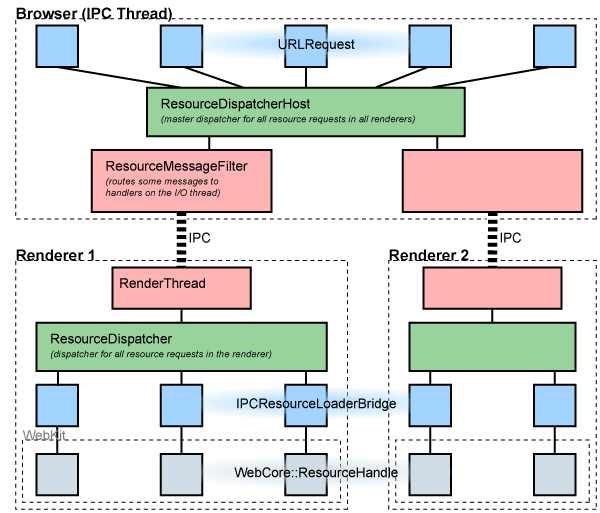Multi-process Resource Loading
This design doc needs update. Some figures contains stale information.
Background
All network communication is handled by the main browser process. This is done not only so that the browser process can control each renderer's access to the network, but also so that we can maintain consistent session state across processes like cookies and cached data. It is also important because as a HTTP/1.1 user-agent, the browser as a whole should not open too many connections per host.
Overview
Our multi-process application can be viewed in three layers. At the lowest layer is the Blink engine which renders pages. Above that are the renderer process (simplistically, one-per-tab), each of which contains one Blink instance. Managing all the renderers is the browser process, which controls all network accesses.
Blink
Blink has a ResourceLoader object which is responsible for fetching data. Each
loader has a WebURLLoader for performing the actual requests. The header file
for this interface is inside the Blink repo.
ResourceLoader implements the interface WebURLLoaderClient. This is the
callback interface used by the renderer to dispatch data and other events to
Blink.
The test shell uses a different resource loader, so provides a different
implementation, non-IPC version of .ResourceLoaderBridge, located in
webkit/tools/test_shell/simple_resource_loader_bridge
Renderer
The renderer's implementation of WebURLLoader, called WebURLLoaderImpl, is
located in content/child/. It uses the global ResourceDispatcher singleton
object (one for each renderer process) to create a unique request ID and forward
the request to the browser via IPC. Responses from the browser will reference
this request ID, which can then be converted back to the RequestPeer object
(WebURLRequestImpl) by the resource dispatcher.
Browser
The RenderProcessHost objects inside the browser receive the IPC requests from
each renderer. It forwards these requests to the global
ResourceDispatcherHost, using a pointer to the render process host
(specifically, an implementation of ResourceDispatcherHost::Receiver) and the
request ID generated by the renderer to uniquely identify the request.
Each request is then converted into a URLRequest object, which in turn
forwards it to its internal URLRequestJob that implements the specific
protocol desired. When the URLRequest generates notifications, its
ResourceDispatcherHost::Receiver and request ID are used to send the
notification to the correct RenderProcessHost for sending back to the
renderer. Since the ID generated by the renderer is preserved, it is able to
correlate all responses with a specific request first generated by Blink.
Cookies
All cookies are handled by our CookieMonster object in /net/base. We do not
share cookies with other browsers' network stacks (e.g. WinINET or Necko). The
cookie monster lives in the browser process which handles all network requests
because cookies need to be the same across all tabs.
Pages can request cookies for a document via document.cookie. When this
occurs, we send a synchronous message from the renderer to the browser
requesting the cookie. While the browser is processing the cookie, the thread
that Blink works on is suspended. When the renderer's I/O thread receives the
response from the browser, it un-suspends the thread and passes the result back
to the JavaScript engine.
